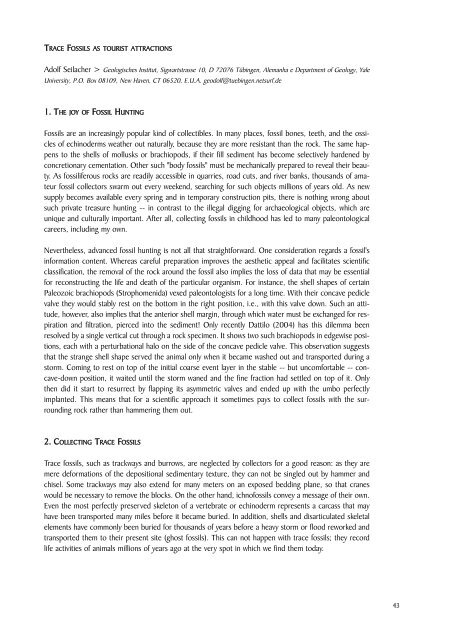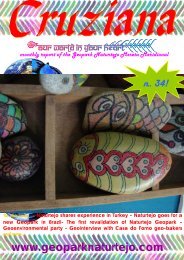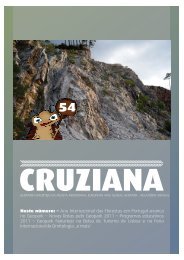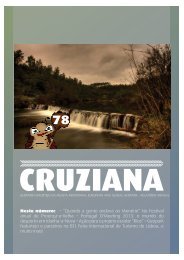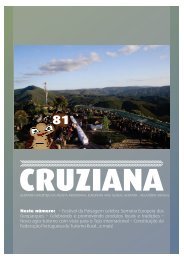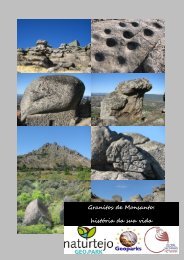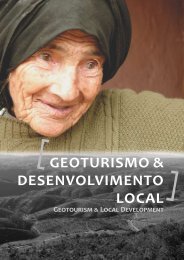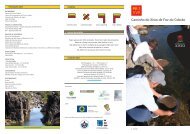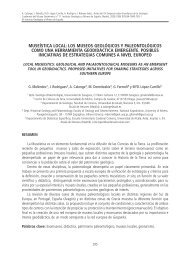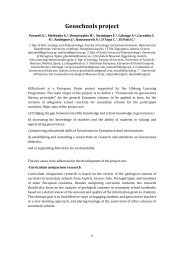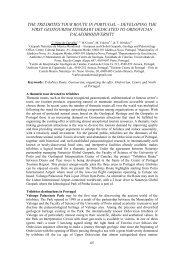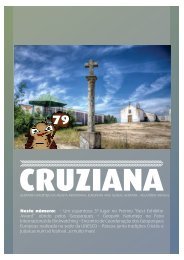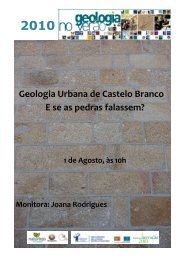Livro de actas - Geopark Naturtejo
Livro de actas - Geopark Naturtejo
Livro de actas - Geopark Naturtejo
- No tags were found...
Create successful ePaper yourself
Turn your PDF publications into a flip-book with our unique Google optimized e-Paper software.
TRACE FOSSILS AS TOURIST ATTRACTIONSAdolf Seilacher > Geologisches Institut, Sigwartstrasse 10, D 72076 Tübingen, Alemanha e Department of Geology, YaleUniversity, P.O. Box 08109, New Haven, CT 06520, E.U.A. geodolf@tuebingen.netsurf.<strong>de</strong>1. THE JOY OF FOSSIL HUNTINGFossils are an increasingly popular kind of collectibles. In many places, fossil bones, teeth, and the ossiclesof echino<strong>de</strong>rms weather out naturally, because they are more resistant than the rock. The same happensto the shells of mollusks or brachiopods, if their fill sediment has become selectively har<strong>de</strong>ned byconcretionary cementation. Other such "body fossils" must be mechanically prepared to reveal their beauty.As fossiliferous rocks are readily accessible in quarries, road cuts, and river banks, thousands of amateurfossil collectors swarm out every weekend, searching for such objects millions of years old. As newsupply becomes available every spring and in temporary construction pits, there is nothing wrong aboutsuch private treasure hunting -- in contrast to the illegal digging for archaeological objects, which areunique and culturally important. After all, collecting fossils in childhood has led to many paleontologicalcareers, including my own.Nevertheless, advanced fossil hunting is not all that straightforward. One consi<strong>de</strong>ration regards a fossil'sinformation content. Whereas careful preparation improves the aesthetic appeal and facilitates scientificclassification, the removal of the rock around the fossil also implies the loss of data that may be essentialfor reconstructing the life and <strong>de</strong>ath of the particular organism. For instance, the shell shapes of certainPaleozoic brachiopods (Strophomenida) vexed paleontologists for a long time. With their concave pediclevalve they would stably rest on the bottom in the right position, i.e., with this valve down. Such an attitu<strong>de</strong>,however, also implies that the anterior shell margin, through which water must be exchanged for respirationand filtration, pierced into the sediment! Only recently Dattilo (2004) has this dilemma beenresolved by a single vertical cut through a rock specimen. It shows two such brachiopods in edgewise positions,each with a perturbational halo on the si<strong>de</strong> of the concave pedicle valve. This observation suggeststhat the strange shell shape served the animal only when it became washed out and transported during astorm. Coming to rest on top of the initial coarse event layer in the stable -- but uncomfortable -- concave-downposition, it waited until the storm waned and the fine fraction had settled on top of it. Onlythen did it start to resurrect by flapping its asymmetric valves and en<strong>de</strong>d up with the umbo perfectlyimplanted. This means that for a scientific approach it sometimes pays to collect fossils with the surroundingrock rather than hammering them out.2. COLLECTING TRACE FOSSILSTrace fossils, such as trackways and burrows, are neglected by collectors for a good reason: as they aremere <strong>de</strong>formations of the <strong>de</strong>positional sedimentary texture, they can not be singled out by hammer andchisel. Some trackways may also extend for many meters on an exposed bedding plane, so that craneswould be necessary to remove the blocks. On the other hand, ichnofossils convey a message of their own.Even the most perfectly preserved skeleton of a vertebrate or echino<strong>de</strong>rm represents a carcass that mayhave been transported many miles before it became buried. In addition, shells and disarticulated skeletalelements have commonly been buried for thousands of years before a heavy storm or flood reworked andtransported them to their present site (ghost fossils). This can not happen with trace fossils; they recordlife activities of animals millions of years ago at the very spot in which we find them today.43


